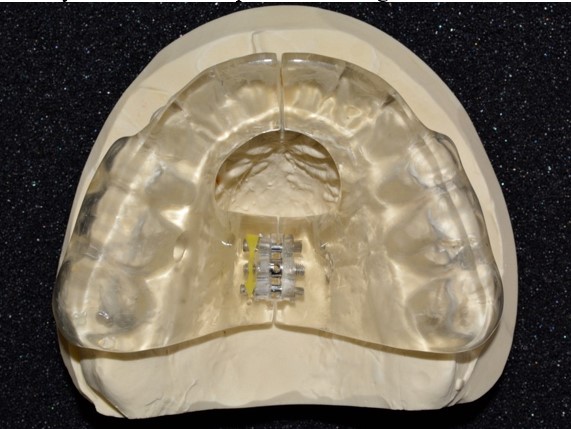On a quiet street in southern Australia, in a large examining room filled with natural light, dentist Joseph Da Cruz examines the jaw of a 51-year-old patient named Carol, who has been plagued for years with headaches, poor sleep, fatigue, and thyroid issues. She has consulted with at least a dozen health professionals, including a Sydney physician who referred her to this office.
With sophisticated X-ray equipment, Da Cruz takes images of her mouth, and studies these. He presents Carol (not her real name) with a treatment plan, which includes creation of a customized dental appliance made of acrylic plastic, an adjustable plate that fits onto the upper teeth, developed by him over a period of years and patented globally.
“That’s why I’m here,” Carol says, “to get one of those things.”
“We can have it for you in three weeks,” says Da Cruz, and Carol smiles broadly, as if, after years of suffering, there’s hope on the horizon.
The device is known as a “SOMA,” short for “Splint Orthopedic Myofunctional Appliance.” It makes the jaw work better. With extreme gentleness, it moves the jaw into its proper alignment and ideal physiological position. This relaxes facial and jaw muscles. Relaxation (“decompression”), accompanied by cranial release, reduces stress and strain in the cranium/neck/jaw complex and thus in the entire body, says Da Cruz. The nervous system is calmed; there is a reduction in dominance by the overly reactive sympathetic nervous system (which controls the “flight-or-flight” response) and there’s enhancement of the parasympathetic nerves. Life energy flows more freely, Da Cruz says (“qi,” to use the Chinese word) and the body moves to a new place of healing.

The result, according to Da Cruz, can be improvement in many bodily functions, including breathing, sleep, digestion, the immune system, allergies, chronic fatigue, depression, anxiety, lymphatic drainage, cerebrospinal fluid flow, hormone production, mental focus, etc. “And,” he adds, “the appliance will alleviate many types of chronic pain, including headaches.” There are no guarantees, he says, but he believes that many people, from age six up, could benefit from a SOMA—many or most people have jaw muscles that are extremely and unnecessarily tight, he says.
As an example of a bodily structure helped by the SOMA, he mentions fascia, the connective tissue system made of collagen, “often obstructed by chronic muscle tension,” he says. This tension, and the resulting inflammation, can cause chemical changes in fascia fibers, he continues, which obstructs acidic waste removal and prevents normal hormone activity.
The SOMA can also assist in orthodontics. “Most orthodontists deal with the horizontal architecture of the teeth and jaw,” Da Cruz says. “That’s the easy part. What’s harder is what I do—dealing with the horizontal problem, the vertical problem, and the backto-front problem, as well as TMJ, occlusion, clenching, and mouth breathing.”
Da Cruz has fitted several thousand patients with his appliances at his office in Quenbeyan, a small city near Canberra, Australia’s capital. Most of his patients are from Australia; he has also worked with people from North America, Europe, Japan, the Middle East, etc.
Born in 1950 in Goa, India, Da Cruz grew up in Nairobi, Kenya. He was a feisty kid, he recalls—independent-minded and athletic, a dedicated field hockey player, a champion arm wrestler, capable of doing dozens of pull-ups while his classmates barely managed one or two—a ball of fire, eager to make his mark in the world.
He received an excellent dentistry education in India, finishing near the top of his class and getting a master’s degree. Emigrating to Australia in 1979 in search of better opportunities, he built a successful general dentistry practice and began raising a family.
In the 1980s he began re-thinking the shibboleths of his profession when one of his patients, a man with eight mercury-based fillings, wanted them removed. Da Cruz investigated the matter, consulted with peers, took safety precautions, and did the work. The patient was pleased.
In 1993, in Canberra, Da Cruz met John Diamond, MD, an Australian-trained psychiatrist and author, a polymath who had investigated many modes of complementary healing, including the dental work of Willie May, DDS, of Albuquerque, New Mexico, who created appliances that appeared to help many health issues. Diamond and Da Cruz discussed May’s work for hours on end. They also talked about neurology, kinesiology, Chinese medicine, orthomolecular therapy, naturopathy, and birth trauma. The latter greatly affects the neck, Diamond said, and may in fact be the core cause of human suffering.



